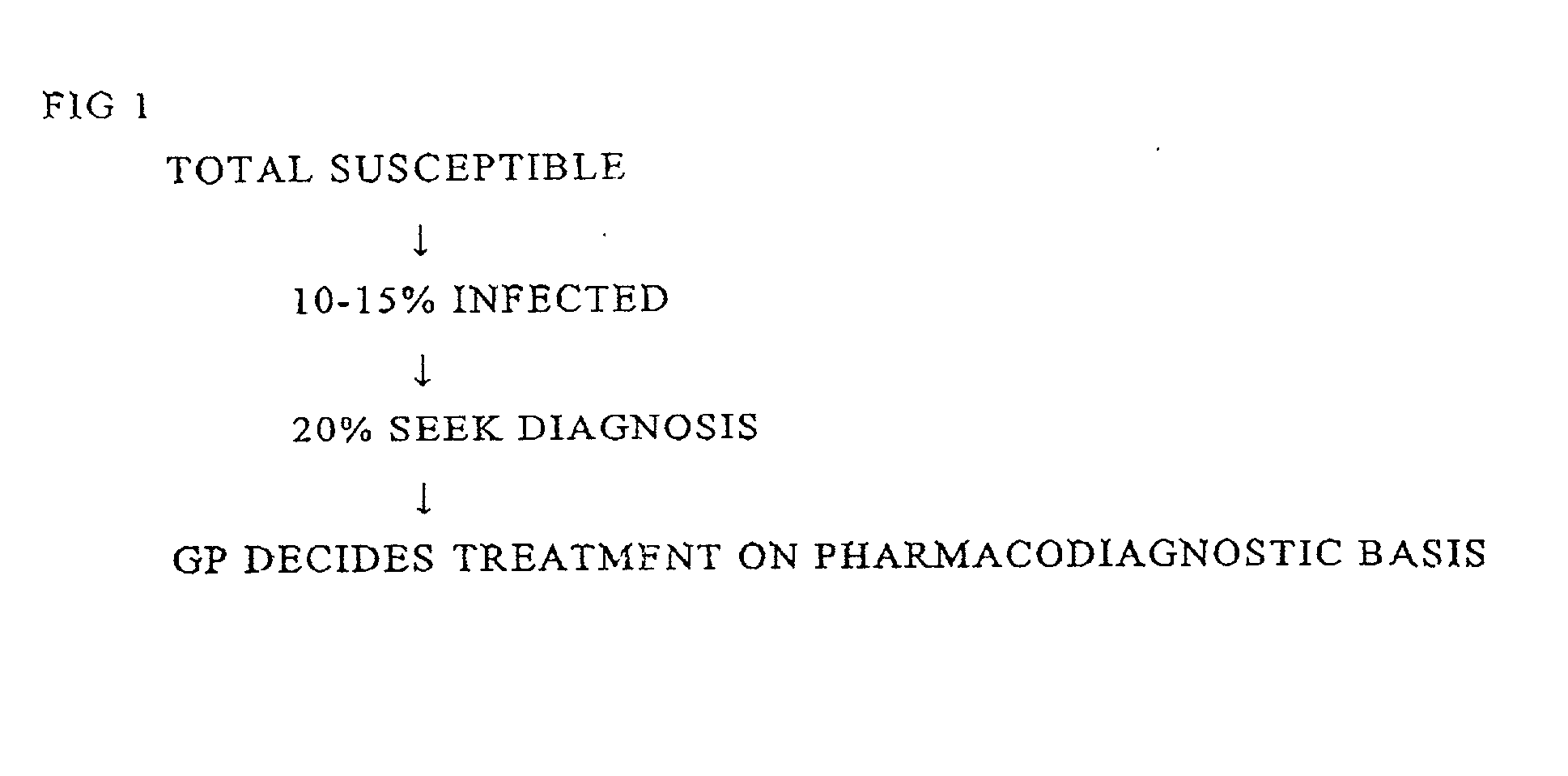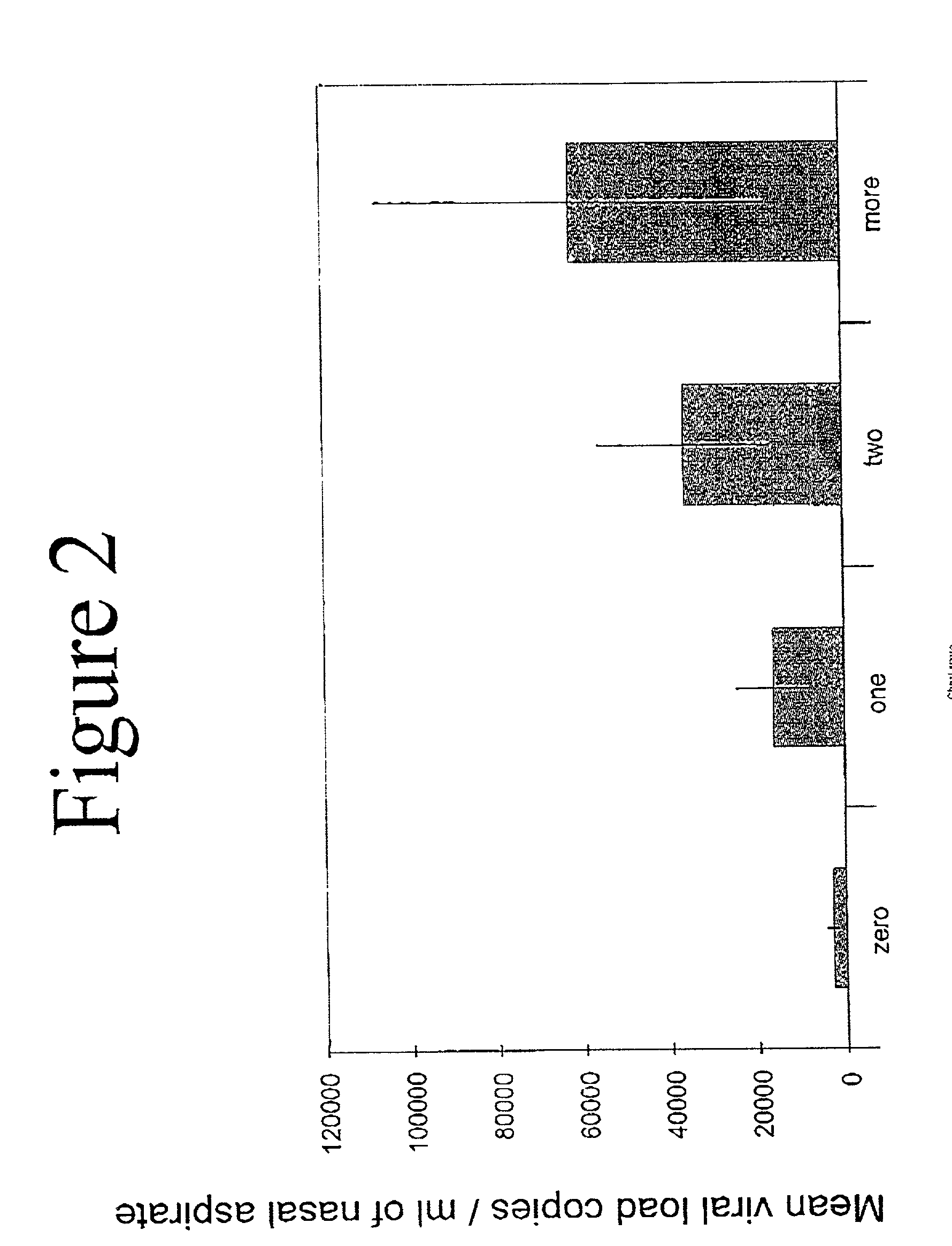Diagnostic method
a diagnostic method and method technology, applied in the field of diagnostic methods, can solve the problems of increased frequency, increased exacerbation risk, and increased exacerbation risk, so as to reduce the damage caused by exacerbation, prevent the onset of exacerbation, and increase the incidence of exacerbation risk
- Summary
- Abstract
- Description
- Claims
- Application Information
AI Technical Summary
Benefits of technology
Problems solved by technology
Method used
Image
Examples
example 2
[0090] In a further study the applicant undertook a viral load analysis of COPD clinical trial samples, Edinburgh (MacNee), to further study the association between virus and exacerbation.
[0091] The study was a single centre study in which 150 patients were studied for 2 years. Patients had 2 base line nasal swabs taken with additional samples taken on exacerbation (nasal swabs and spontaneous sputum).
[0092] The frequency of exacerbation that patients experienced was noted. The results of the investigations are illustrated graphically in FIG. 3.
[0093] The graph shows the number of exacerbations that patients experienced. 125 samples were analysed from 59 COPD patients. 58 were baseline samples and 67 were from exacerbation. The median age of the patients was 67 years (range 49-85 years).
[0094] The Percentage of virus positives at July 2000 was as set out in table 3 below:
4 TABLE 3 EXACERBATIONS BASELINE NUMBER OF 67 58 SAMPLES NUMBER OF VIRUS 15 3 POSITIVES % VIRUS POSITIVE 22 5
[009...
example 3
[0113] Lister study (Stanley).
[0114] A Cohort of 12 mild to severe COPD patients were followed both pre and post exacerbation.
[0115] The 12 patient study lasted for 12 weeks.
[0116] Nasal swabs were taken 3 times / week or daily when symptom scores and (FEV.sub.1) indicated an exacerbation. Exacerbation was defined as 2 major or 1 major and 1 minor symptom for 2 consecutive days. Six out of twelve patients experienced exacerbation.
[0117] Patient 1 had 2 episodes.
[0118] Patients 3,4,6 & 8 had 1 episode.
[0119] Patient 10 had some symptoms for most of the study.
[0120] Of the 2 exacerbations analysed, both were Picornavirus positive.
[0121] Their respective profiles are illustrated in FIGS. 5 and 6.
[0122] FIG. 5 is the profile of patient 3. An increase in viral load can be seen to precede the exacerbation.
[0123] FIG. 6 is the patient profile of patient 1 and again an increase in viral load can be seen to precede the exacerbations.
[0124] These findings are of particular significance in that ...
PUM
| Property | Measurement | Unit |
|---|---|---|
| fluorogenic real time PCR assay | aaaaa | aaaaa |
| volume | aaaaa | aaaaa |
| colour | aaaaa | aaaaa |
Abstract
Description
Claims
Application Information
 Login to View More
Login to View More - R&D
- Intellectual Property
- Life Sciences
- Materials
- Tech Scout
- Unparalleled Data Quality
- Higher Quality Content
- 60% Fewer Hallucinations
Browse by: Latest US Patents, China's latest patents, Technical Efficacy Thesaurus, Application Domain, Technology Topic, Popular Technical Reports.
© 2025 PatSnap. All rights reserved.Legal|Privacy policy|Modern Slavery Act Transparency Statement|Sitemap|About US| Contact US: help@patsnap.com



